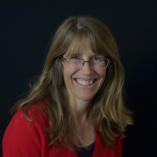



04May 2017
Dr. Barbara Helmkamp - “The Heavens Declare: Starlight
and the Age of the Cosmos OR Where will you hang your
hat?”
Note: This meeting was held at Lutheran High School in Parker,
Colorado.
How does the apparent age of the universe (whatever you think this might be) relate to the Biblical account of creation? Does the so-called “starlight travel problem” (the BIG-ness of the universe) stand in the way of your accepting the Biblical account of creation at face value? Is the “Big Bang” hypothesis (pick any of its many variant forms) viable, or is it bankrupt, with more BAND-AIDs than healthy skin? Barbara Helmkamp will address these questions in an introductory-level talk about cosmology and creation. About Dr. Helmkamp: Dr. Barbara S. Helmkamp has a Ph.D. in physics from Louisiana State University and a B.S. Engineering in physics from Colorado School of Mines, and she worked as a petrophysical engineer for the Shell Oil Companies between undergraduate and graduate studies. She completed the Lutheran Teacher Colloquy from Concordia University Texas while teaching at St. Mark Lutheran Church & School in Houston, where she was subsequently called. She is currently on the faculty of Veritas Scholars Academy (V.S.A. is an online school out of Lancaster, PA). She also taught at Credo Academy (Credo is a home school co-op in Lone Tree, CO) as well as having overseen her daughters’ high school educations from home. Her older daughter graduated with Honors from V.S.A. in 2015 and is currently a sophomore at University of Iowa, and her younger daughter graduates Highest Honors in June and will attend University of Wyoming in the fall. Barbara, her husband Bob, and their daughters are members of Christ Our Savior Lutheran Church in Elizabeth, Colorado. Print Flyer: Click Here Print Bulletin Insert: Click Here A big “THANK YOU” to Dr. Barbara Helmkamp for doing such a terrific job on a very difficult topic! She was even gracious enough to further research one of the questions that came up. Thank you Dr. Helmkamp! Question: What does the Hartnett-Carmeli model predict from future better-than-Hubble telescopes (like the James Webb telescope with its tentative Oct 2018 launch date)? Answer: Besides better images of what has already been “seen”, there would just be more of the same! That is, more and more stellar objects and systems at all ranges of process for as far as we can “see” (i.e., at a higher and higher redshifts until undetectable), OR, if the edge of created matter (within created space) is inside the redshift horizon, AND if any “intrinsic” redshift (component of a source’s redshift that is unrelated to either Hubble flow or Doppler shift arising from motion within the cosmos) can be corrected for (along the lines of Halton Arp’s ideas). THEN there would be an identifiable radius beyond which there are no more sources. The key differences between the Hartnett-Carmeli model and the current version of the “Big Bang” (FLRW Lambda-CDM) model, which distinguish what each model would predict, are as follows: 1) the Hartnett-Carmeli cosmos has an edge with earth at/near its center in 3D space while the Big Bang model has neither an edge nor a center because Hoogeneity is assumed per the Cosmological Principle; and 2) all levels of process exist at all distances in the Hartnett-Carmeli model, because looking “out there” is tantamount to looking back at Day 4 of Creation (when “He made the stars also” in conjunction with an accelerated stretching of the cosmos which dilated time on earth), rather than looking “out there” being equated to looking back in time, in the uniformitarian sense, to earlier and earlier stages of the Big Bang’s evolutionary “story,” ultimately to some kind of uniform radiation fog. So, what would I do if the Hartnett-Carmeli model fails to account for future observations? I would reject the model, of course (or modify it to account for observation - same as all scientist do). But I will hold to the Biblical account of a recent 6-Day creation regardless, because God does not lie, and I understand Genesis to be God’s account of origins. I can reject a Creationist model that fails, because while the model is (and should be!) based on the Bible, the Bible does not depend on the validity of the model! The Big Bang model is bankrupt on so many levels already (besides philosophy) that a radically new model is needed regardless. I do not understand why so many scientists cling to it, unless they lack the background to really understand it, or they are committed Materialists and there’s just no other explanation that does not point to a Creator (per Romans 1:20).




04May 2017
Dr. Barbara Helmkamp - “The Heavens
Declare: Starlight and the Age of the
Cosmos OR Where will you hang your hat?”
Note: This meeting was held at Lutheran High
School in Parker, Colorado.
How does the apparent age of the universe (whatever you think this might be) relate to the Biblical account of creation? Does the so-called “starlight travel problem” (the BIG-ness of the universe) stand in the way of your accepting the Biblical account of creation at face value? Is the “Big Bang” hypothesis (pick any of its many variant forms) viable, or is it bankrupt, with more BAND-AIDs than healthy skin? Barbara Helmkamp will address these questions in an introductory-level talk about cosmology and creation. About Dr. Helmkamp: Dr. Barbara S. Helmkamp has a Ph.D. in physics from Louisiana State University and a B.S. Engineering in physics from Colorado School of Mines, and she worked as a petrophysical engineer for the Shell Oil Companies between undergraduate and graduate studies. She completed the Lutheran Teacher Colloquy from Concordia University Texas while teaching at St. Mark Lutheran Church & School in Houston, where she was subsequently called. She is currently on the faculty of Veritas Scholars Academy (V.S.A. is an online school out of Lancaster, PA). She also taught at Credo Academy (Credo is a home school co-op in Lone Tree, CO) as well as having overseen her daughters’ high school educations from home. Her older daughter graduated with Honors from V.S.A. in 2015 and is currently a sophomore at University of Iowa, and her younger daughter graduates Highest Honors in June and will attend University of Wyoming in the fall. Barbara, her husband Bob, and their daughters are members of Christ Our Savior Lutheran Church in Elizabeth, Colorado. Print Flyer: Click Here Print Bulletin Insert: Click Here A big “THANK YOU” to Dr. Barbara Helmkamp for doing such a terrific job on a very difficult topic! She was even gracious enough to further research one of the questions that came up. Thank you Dr. Helmkamp! Question: What does the Hartnett-Carmeli model predict from future better-than-Hubble telescopes (like the James Webb telescope with its tentative Oct 2018 launch date)? Answer: Besides better images of what has already been “seen”, there would just be more of the same! That is, more and more stellar objects and systems at all ranges of process for as far as we can “see” (i.e., at a higher and higher redshifts until undetectable), OR, if the edge of created matter (within created space) is inside the redshift horizon, AND if any “intrinsic” redshift (component of a source’s redshift that is unrelated to either Hubble flow or Doppler shift arising from motion within the cosmos) can be corrected for (along the lines of Halton Arp’s ideas). THEN there would be an identifiable radius beyond which there are no more sources. The key differences between the Hartnett-Carmeli model and the current version of the “Big Bang” (FLRW Lambda-CDM) model, which distinguish what each model would predict, are as follows: 1) the Hartnett-Carmeli cosmos has an edge with earth at/near its center in 3D space while the Big Bang model has neither an edge nor a center because Hoogeneity is assumed per the Cosmological Principle; and 2) all levels of process exist at all distances in the Hartnett-Carmeli model, because looking “out there” is tantamount to looking back at Day 4 of Creation (when “He made the stars also” in conjunction with an accelerated stretching of the cosmos which dilated time on earth), rather than looking “out there” being equated to looking back in time, in the uniformitarian sense, to earlier and earlier stages of the Big Bang’s evolutionary “story,” ultimately to some kind of uniform radiation fog. So, what would I do if the Hartnett-Carmeli model fails to account for future observations? I would reject the model, of course (or modify it to account for observation - same as all scientist do). But I will hold to the Biblical account of a recent 6-Day creation regardless, because God does not lie, and I understand Genesis to be God’s account of origins. I can reject a Creationist model that fails, because while the model is (and should be!) based on the Bible, the Bible does not depend on the validity of the model! The Big Bang model is bankrupt on so many levels already (besides philosophy) that a radically new model is needed regardless. I do not understand why so many scientists cling to it, unless they lack the background to really understand it, or they are committed Materialists and there’s just no other explanation that does not point to a Creator (per Romans 1:20).




























